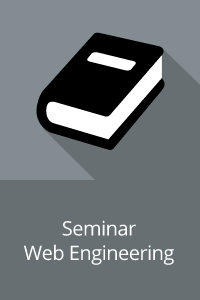
Seminar Web Engineering (SS 2018)
Welcome to the homepage of the Seminar Web Engineering
This website contains all important information about the seminar, including links to available topics as well as information about the seminar process in general.
The interdisciplinary research area Web Engineering develops approaches for the methodological construction of Web-based applications and distributed systems as well as their continuous development (evolution). For instance, Web Engineering deals with the development of interoperable Web Services, the implementation of web portals using service-oriented architectures (SOA), fully accessible user interfaces or even exotic web-based applications that are voice controlled via the telephone or that are represented on TV and Radio.
The following steps are necessary to complete the seminar:
- Preparation of a presentation about the topic assigned to you.
- An additional written report of your topic.
- Each report is reviewed by two or three other particpants.
Seminar chairs



Dr.-Ing. Sebastian Heil
Contact
If you have any questions concerning this course or the exam as a participant, please contact us via OPAL.
Participants
The seminar is offered for students of the following programmes (for pre-requisites, please refer to your study regulations):
- Bachelor Informatik (Proseminar 500110 /Hauptseminar 500070)
- Bachelor Angewandte Informatik (Proseminar 500110 / Hauptseminar 500270)
- Bachelor Informatik und Kommunikationswissenschaften (Proseminar 500110 / Hauptseminar 500070)
- Master Informatik für Sozial- und Geisteswissenschaftler (Proseminar 500110 /Forschungsseminar 500090)
- Master Informatik (Forschungsseminar M_01)
- Master Angewandte Informatik (Forschungsseminar 500090)
- Master Web Engineering (Seminar Web Engineering 500410)
If your programme is not listed here, please contact us prior to seminar registration and indicate your study programme, the version (year) of your study regulations (Prüfungsordnungsversion) and the module number (Modulnummer) to allow us to check whether we can offer the seminar for you and find an appropriate mapping.
Registration
You may only participate after registration. The registration opens on 02.04.2018 at 12:00 and und ends on 08.04.2018 at 23:59. There is an overall capacity of 20 slots available. As these slots are usually rather quickly booked, we recommend to complete your registration early after registration opens.
Themen (und VSR-Ansprechpartner)
Fragen:
- What is ADM?
- How is the current state of play, i.e. how far are the standards and are they applied?
Literatur:
- http://www.omg.org/news/meetings/workshops/adm-2005.htm
- KDM
- ASTM
- REMICS
- MIGRARIA
Fragen:
- What is different in comparison to HTTP/1.1?
- Which challenges does it adress?
- What is HTTP/2 Server Push?
Fragen:
- What is the difference between data validation, data verification and data plausibility?
- How is data testing done in HTML5, Angular, ASP.NET or other modern web frameworks?
- Which online tools exist for data plausibility checks so far?
Fragen:
- What is it?
- Why do we need MFA?
- Different kind of factors
- What solutions exist?
- Advantages/Disadvantages
Fragen:
- What is content trust?
- How can content trust get initialized without human interaction?
- Is any meta data needed for calculating content trust?
Fragen:
- What is Concept Assignment and what is Concept Slicing, how do they work?
- Where can it be applied?
- Create a practical demonstration to automatically assign concepts to a sample open source code (in C, C++, C
- or Java).
Literatur:
- Gold, N. E., Harman, M., Binkley, D., & Hierons, R. M. (2005). Unifying program slicing and concept assignment for higher-level executable source code extraction. Software: Practice and Experience, 35(10), 977–1006. http://doi.org/10.1002/spe.664
- http://dl.acm.org/citation.cfm?id=2943738
Fragen:
- what is different in application development on top of IoT?
- what are the challenges for application development on top of IoT?
- What solutions exists in this area?
- scenarios
Fragen:
- What is Business Process Management (BPM) and thier capabilities?
- What is Case Management (CM) and thier capabilities?
- What are methodological di fferences between BPM and CM?
- What are the modelling requirements of an unstructured business process?
- what is the diffrences between unstructured und structured business process?
Literatur:
- Van der Aalst W.M.P. Business process management: A comprehensive survey. ISRN Software Engineering, 2013.
- Fundamentals of Business Process Management Autoren: Dumas, M., La Rosa, M., Mendling, J., Reijers, H.
- Case handling: a new paradigm for business process support
- https://www.researchgate.net/publication/222423876_Case_Handling_A_New_Paradigm_for_Business_Process_Support
Fragen:
- What is a Digital Workplace?
- What is the Essential Elements Of The Digital Workplace?
- How can Organizations make a Digital Workplacea sustainable Proposition and a competitive Advantage?
Literatur:
- https://www.intergator.de/loesungen/weitere-intergator-anwendungen/zentrale-unternehmenssuche-im-digital-workplace/
- Jane McConnell: Trends für Intranet und digitalen Arbeitsplatz. In: Frank Wolf (Hrsg.): Social Intranet – Kommunikation fördern – Wissen teilen – Effizient zusammenarbeiten. Carl Hanser Verlag, 2011, ISBN 3-446-42791-0
- Frank Schönefeld: Social Intranet – Die neue Rolle des Intranets für den digitalen Arbeitsplatz. In: Frank Wolf (Hrsg.): Social Intranet – Kommunikation fördern – Wissen teilen – Effizient zusammenarbeiten. Carl Hanser Verlag, 2011, ISBN 3-446-42791-0, S. 14–40
Fragen:
- What are the different artificial intelligence planning algorithms?
- Which algorithms are better suited for IoT devices?
- What new features need to be considered when planning for IoT devices?
- Demo: implement the CSP planning or Fast Downward planning system for 2 IoT devices.
Fragen:
- How can I use a Blockchain?
- Which types of Blockchains exist?
- What about Interoperability?
Fragen:
- What is ontology mapping?
- What are the methods?
Fragen:
- What is design mining, which information can be extracted from web user interfaces?
- Which methods exist to support visual analysis of web user interfaces based on non-HTML input (e.g. from screenshots) and which common representations (formats, concepts etc.) of mining results are used?
- Which methods focus on similarity aspects between user interfaces and how do they do so?
Literatur:
- http://vis.stanford.edu/files/2013-Webzeitgeist-CHI.pdf
- https://dl.acm.org/citation.cfm?id=2788902
- A. Jahanian: Quantifying Aesthetics of Visual Design Applied to Automatic Design
- https://dl.acm.org/citation.cfm?id=2892537
- ViDE/VIPS
- https://www.researchgate.net/publication/254060980_Web_Interface_Interpretation_Using_Graph_Grammars
- https://link.springer.com/chapter/10.1007%2F978-3-319-05717-0_7
- https://link.springer.com/chapter/10.1007/978-3-319-60131-1_22
- http://eprints-phd.biblio.unitn.it/1773/
- https://dl.acm.org/citation.cfm?id=3053238
Fragen:
- What is a Transpiler and why is it needed?
- How do they work?
- What different Transpilers exist and how to they compare to each other?
Fragen:
- What is IoT Botnet?
- How they can be prevented?
- Explain mechanism and the danger
Fragen:
- Summarize the two recommendations
- Provide an example scenario using those approaches
Fragen:
- What is it?
- What is it used for?
- Advantages/Disadvantages? Implementations?
- Alternatives?
Literatur:
Fragen:
- What are Progressive Web Apps?
- How they work?
- How they affect the business applications?
Fragen:
- What is DNS?
- How des DNSSEC extend DNS?
- Why should one use DNSSEC?
- Alternatives?
- Attackvectors?
Fragen:
- What performance metrics (KPI vs. OKR) are used to measure the productivity of activites in Web-product development process?
- How does free the Development Process from the downward spiral?
- Which kind of Framework does a web-product Enterprise use to balance Development Process?
Literatur:
- Hailey, J. &. S. M., 2004. 'Measuring Success: Issues in Performance Management. Oxford: INTRAC.
- https://www.talentcove.com/okrs/google-okrs-case-study.html
- Gothelf , J. & Seiden, J., 2012. Lean UX: Applying Lean Principles to Improve User Experience. Sebastopol, CA 95472: O'Reilly and Associates
- https://www.researchgate.net/publication/237602737
Fragen:
- Challenges
- Applications/Scenarios
- Technologies
Literatur:
- #Own Research
Fragen:
- What are Web Compontents?
- How is component-based web development supported in modern libraries?
- How do the approaches differ?
Literatur:
- Own Research
Fragen:
- What are the currently most used JS frameworks?
- What are their benefits and weaknesses?
- Which trends are reoccuring in all major frameworks?
Literatur:
- Own Research
Fragen:
- What are serverless applications?
- Pros and cons?
- Comparision to regular server-based application?
- Who is offering serverless applications and how?
- Use cases?
Literatur:
- Amazon Lambdas
- Google Cloud Functions
- Own Research
Fragen:
- What is React JS?
- What are the distinctive features of React JS?
- What is Flux and how it is related to react?
Seminar Opening
The seminar opening took place on Thursday, 19 April 2018.
If you have not done this so far, please register in the VSR Seminar Workflow System.
The slides of the seminar opening are available here.
Short Presentation
In your short presentation, you will provide a brief overview on your selected topic.
This includes the following aspects:
- What is in your topic?
- Which literature sources did you research so far?
- What is your idea for a demonstration?
The short presentation should be no longer than 3 slides (in addition to your title slide) and take max. 5 minutes. Following your short presentations, the advisors will provide you with feedback and hints for your full presentations.
Hints for your Presentation
- As rule of thumb you can plan for 2 minutes per slide. Significantly more slides per minute can be difficult to perceive for the audience.
- Prior to creating your presentation, you should think about: What should be the main message of my presentation? What should the audience remember after my presentation?
Based on these considerations you should create your presentation. - Here you can find some useful hints http://www.garrreynolds.com/Presentation/
Seminar Days
The seminar presentations will be held in half-day blocks. The dates will be announced here later.
Report
- Important hints on citing:
- Any statement which does neither belong to general knowledge nor stem from the author has to be provided with a reference to its original source.
- "When to Cite Sources"- Good overview by Princeton University
- Examples for citations can be found in the IEEE Citation Reference
- Web References have to be cited with author, title, date, URL and date of last access. Examples:
- [...] M. Nottingham and R. Sayre, "The Atom Syndication Format - Request for Comments: 4287", 2005. [Online]. Available: http://www.ietf.org/rfc/rfc4287.txt. [Accessed: Feb. 18, 2008].
- [...] Microsoft, "Microsoft Office SharePoint Server 2007 Homepage", 2007. [Online]. Available: http://office.microsoft.com/en-us/sharepointserver/. [Accessed: Jan. 02, 2007].
- The url has to be included as a hyperlink ("clickable") if technically possible.
- Further Information and Hints:
- Please use, as far as possible, the HTML elements which are used in the template. Changes to the CSS file are not allowed and will be ignored.
- Carefully check spelling and grammar of your reports, preferably using software support such as OpenOffice, Microsoft Word or LanguateTool, before uploading it.
- Check that your HTML is valid using the W3C Validator
Review
- Each seminar participant has to review exactly three reports. The reviews are not anonymous.
- Use the review forms provided in the VSR Seminar Workflow, one per report.
- Following the review phase, each seminar participant will receive the three peer reviews of his report and, if necessary, additional comments by the advisors. You will then have one more week to improve your report according to this feedback.
- The seminar grade will consider the final report.
All comments in the reviews are for improving the text and therefore in the interest of the author.


